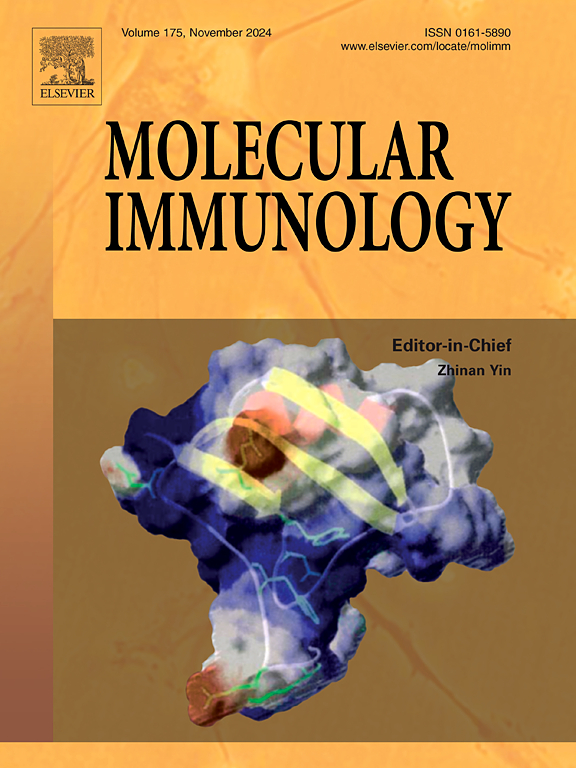DAP12通过调节巨噬细胞浸润影响UPEC或LPS引起的急性炎症反应
IF 3
3区 医学
Q2 BIOCHEMISTRY & MOLECULAR BIOLOGY
引用次数: 0
摘要
尿路感染(UTI)是一种常见的细菌感染,主要由尿路致病性大肠杆菌(UPEC)引起。严重的尿路感染可导致肾脏损害,这与m1型巨噬细胞浸润增加密切相关。dnax -活化蛋白12 kD (DAP12)广泛表达于髓细胞和NK细胞中,可与TREM受体相互作用介导多种免疫反应。我们的研究表明,DAP12缺失显著减轻了UPEC感染引起的肾损伤,这一现象与巨噬细胞浸润减少密切相关。进一步研究表明,在UPEC感染过程中,DAP12直接调控巨噬细胞的极化。在大肠杆菌LPS诱导的内毒素休克模型中,DAP12缺乏同样降低了小鼠的死亡率并抑制了LPS诱导的巨噬细胞极化。综上所述,这些发现表明TREM1-DAP12信号通路在UPEC感染引起的肾损伤中起着至关重要的作用,表明该通路可以作为治疗UPEC诱导的肾损伤的新的治疗靶点。本文章由计算机程序翻译,如有差异,请以英文原文为准。
DAP12 affects the acute inflammatory response caused by UPEC or LPS by regulating macrophage infiltration
Urinary tract infection (UTI) is a prevalent bacterial infection, predominantly caused by uropathogenic Escherichia coli (UPEC). Severe UTIs can lead to kidney damage, which is closely associated with increased infiltration of M1-type macrophages. DNAX-activating protein of 12 kD (DAP12) is extensively expressed in myeloid cells and natural killer (NK) cells, and it can interact with TREM receptors to mediate various immune responses. Our study revealed that DAP12 deletion significantly mitigated kidney injury induced by UPEC infection, a phenomenon strongly correlated with reduced macrophage infiltration. Further investigation demonstrated that DAP12 directly regulates the polarization of macrophages during UPEC infection. In an endotoxin shock model induced by LPS derived from E. coli, DAP12 deficiency similarly decreased mortality and inhibited LPS-induced macrophage polarization in mice. Collectively, these findings suggest that the TREM1-DAP12 signaling pathway plays a critical role in kidney injury caused by UPEC infection, indicating that this pathway could serve as a novel therapeutic target for treating UPEC-induced kidney damage.
求助全文
通过发布文献求助,成功后即可免费获取论文全文。
去求助
来源期刊

Molecular immunology
医学-免疫学
CiteScore
6.90
自引率
2.80%
发文量
324
审稿时长
50 days
期刊介绍:
Molecular Immunology publishes original articles, reviews and commentaries on all areas of immunology, with a particular focus on description of cellular, biochemical or genetic mechanisms underlying immunological phenomena. Studies on all model organisms, from invertebrates to humans, are suitable. Examples include, but are not restricted to:
Infection, autoimmunity, transplantation, immunodeficiencies, inflammation and tumor immunology
Mechanisms of induction, regulation and termination of innate and adaptive immunity
Intercellular communication, cooperation and regulation
Intracellular mechanisms of immunity (endocytosis, protein trafficking, pathogen recognition, antigen presentation, etc)
Mechanisms of action of the cells and molecules of the immune system
Structural analysis
Development of the immune system
Comparative immunology and evolution of the immune system
"Omics" studies and bioinformatics
Vaccines, biotechnology and therapeutic manipulation of the immune system (therapeutic antibodies, cytokines, cellular therapies, etc)
Technical developments.
 求助内容:
求助内容: 应助结果提醒方式:
应助结果提醒方式:


